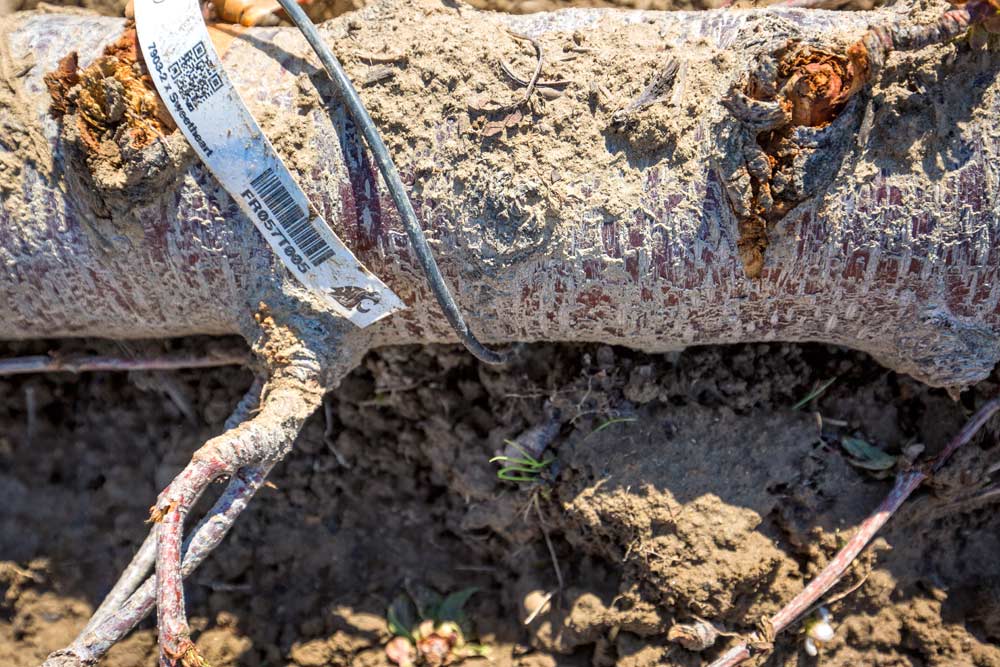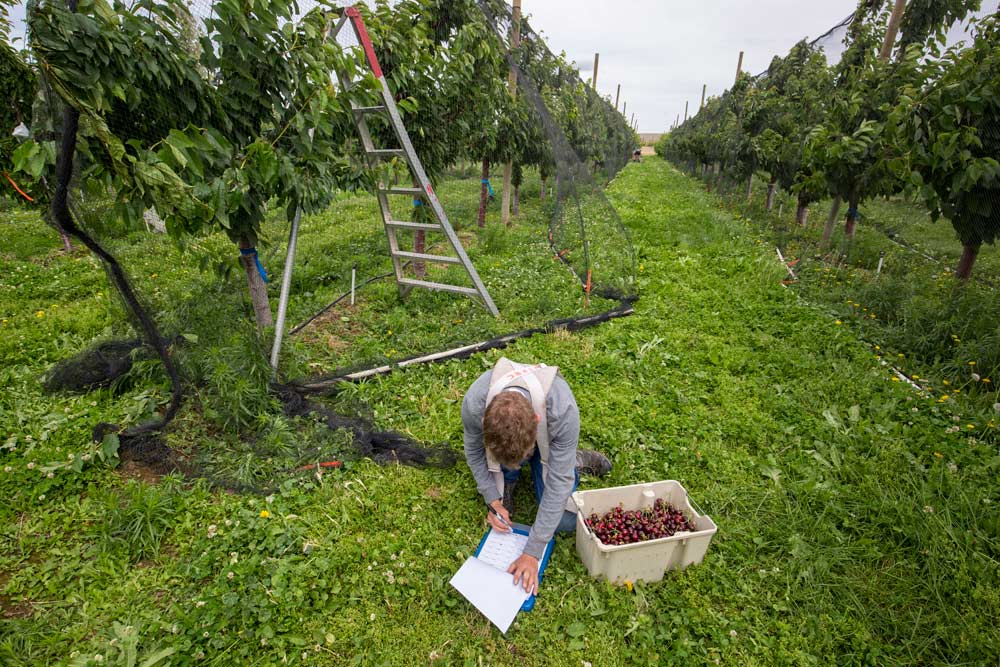
A bulldozer sits idle after pushing over a block of Washington State University sweet cherry breeding program trees at the university’s Prosser, Washington, test orchard in April. (TJ Mullinax/Good Fruit Grower)
After several years of evaluation, time is up for about 2,500 cherry trees — more than half the phase one trees at Washington State University’s sweet cherry breeding program in Prosser, Washington.
Crews are also pulling out hundreds of phase 2 trees and parent trees.
“They’ve had the chance to reveal their potential and they haven’t, so we feel confident that we can throw them out,” said Cameron Peace, a WSU geneticist and interim program director.
Ripping out those underperforming trees is part of a broad effort to renovate the breeding program, which has struggled to discover winning new varieties.
The goal is to get the program on an efficient new foundation to set up the new breeder — who is expected to be hired later this year — for success.
“We are streamlining things, we’re getting things all ready for the new breeder so they can hit the ground running,” Peace said. “We are streamlining the horticultural management, making sure things are healthy and revealing their true genetic potential, and doing the performance evaluations to get to that genetic potential.”
In addition to shrinking the orchard’s footprint, the breeding program is adopting a new online database, changing its evaluation protocol to be more efficient, adding storage tests, adding new protections for its block of parent trees and increasing the focus on early and late-season mahogany cultivars.
That’s a lot of work for one season, but since no new crosses are being made this year, labor can focus on the program’s renovation instead of propagation.
Meanwhile, there are several promising trees in the early stages of the breeding program, said Ines Hanrahan, project manager for the Washington Tree Fruit Research Commission who has been working with the breeding program on evaluations for the past two years.
“Basically, of the young trees, we had five late blush selections and one early mahogany that looked good last year. By looked good, I mean met its requirements for size and firmness,” Hanrahan said. A few other young trees showed promise on harvest timing, but didn’t produce enough fruit for full evaluation last year.
“On mature trees, the trees we have evaluated already for several years, we have three blushes that look good,” she said of the phase two trees. “We also have two mahoganies, but they are mid-season. People don’t really want mid-season unless it’s fantastic.”
It’s an exciting time for the program because after this season, there should be enough good data to make decisions about advancing some of the promising varieties, and more than a dozen more are expected to fruit for the first time, she said.
New breeder, same direction
WSU plans to begin advertising the breeder position this month, said Rich Koenig, associate dean and director of WSU Extension, and a search committee is being formed. The breeder position has been empty since Nnadozie Oraguzie, who joined the program in 2008, left in early 2016.
The Washington Tree Fruit Research Commission and the Oregon Sweet Cherry Commission are chipping in $150,000 for the first two years of the new breeder’s salary, said Mike Willett, manager of the research commission, to ensure that tight university budgets don’t delay the hiring process.
That financial support from growers shows how important the breeding program is to the industry, Willett said.
But, by many accounts the breeding program has floundered in recent years on its primary focus: new mahogany varieties for the early and late season.
Growers want superior cultivars to replace Chelan, which runs small, and Sweetheart, which is very susceptible to powdery mildew, Peace said.
Replacing those two cultivars will be the focus of about 80 percent of the program’s work, with the remaining effort targeting early and later blush varieties and a mahogany variety that is suited for mechanical harvest.
That sounds straightforward but the challenge is that every year, about 75 percent of new seedlings produced from crosses actually ripen in the middle of the season, Peace said. That’s just how cherry trees work, but it results in more time spent analyzing less desired cherries.
Now, the program has decided to “raise the bar” on those middle season cherries: If they aren’t exceptionally large or firm or delicious, they get tossed from further consideration right away.
In the orchard, it works like this: researchers walk the rows and collect ripe cherries. Each one is examined for size and firmness, then cracking, doubling or off-flavors.
What’s considered a passing grade is slightly different for each market class the program is trying to develop, Peace said.
In the early season, moderately sized cherries can pass because the bar they are trying to best is relatively small Chelan, for example. Later in the season, similarly sized cherries will not pass.
This process is then repeated in the lab with more detail. But under a new streamlined protocol, once a cherry fails one category, it’s tossed from consideration. “In the past, everything was evaluated, even if they failed on one of the thresholds,” Peace said.
This is saving staff time and allowing them to take on a new analysis — looking at the cherries after three weeks in cold storage to see which are commercially viable.
Leaner and greener
Over the past two years, the breeding program has focused on improving the health of its orchards so that the true genetic potential of new genotypes can shine and so the breeding parents they want to keep for the long term are well protected.
This year, the team is budding some of the parents in the greenhouse for planting in pots. Potted trees offer more flexibility, because controlled greenhouse conditions can change the tree’s bloom timing so that it coordinates with another parent that the breeder wants to cross with, Peace said.
Also, potted “father” trees can be moved around the orchard and paired with a mother tree under a net to make crosses.
“If both mum and dad are big trees in the ground, you can’t do that,” Peace said.

Barcodes on the cherry trees in the Washington State University’s sweet cherry breeding program make it easier for researchers to identify promising trees and keep track of the data. These trees showed undesirable traits and were in the process of being removed from the program on April 20, 2017, at the WSU Prosser, Washington, Extension test orchard. (TJ Mullinax/Good Fruit Grower)
Other planned updates include an as-yet-to-be-determined structural protection for the parent trees in the orchard and a new electronic database that will also increase the efficiency of field work this year, Peace said — scan a barcode on each tree and the database app will pull up its performance history and parentage, along with quick-check boxes for evaluation criteria.
Still, moving from promising new seedlings to a field-tested cultivar will always take time.
It’s understandable that growers want new varieties as soon as possible, but it’s important to get several years of data on the new trees before advancing them, Hanrahan said.
That helps separate out the influence of a hot year, like 2015, with early ripening. In phase 2, the program typically gathers three years of data on five trees of each of the 37 cultivars under consideration. Only the best of the best move to phase three, when 100 trees are planted in commercial orchards.
“I wouldn’t recommend doing it faster, because there are too many variables,” Hanrahan said. “Each time you advance something you want to be careful not to advance it too early, otherwise the costs of the program explode, and you don’t want to miss a fatal flaw that might not express itself every year.” •
ONLINE EXTRA
DNA tests give WSU sweet cherry breeding program a head start on narrowing down the top candidates.

Kevin Koepcke, a horticultural intern with the Washington Tree Fruit Research Commission, collects cherries and data in the phase two block of Washington State University’s sweet cherry breeding program during the 2016 harvest. This year the data collection is going digital. (TJ Mullinax/Good Fruit Grower)
DNA tests
Washington State University’s new cherry breeder will benefit from seven DNA marker tests already developed by a research team led by Cameron Peace, a WSU geneticist and interim program director of the sweet cherry breeding program, and several more such tests are in the pipeline.
DNA tests can save breeding programs valuable time and resources by enabling them to only plant the seedlings that carry desirable traits.
All new seedlings are tested for fruit color and harvest timing, and the results are used to sort seedlings for further evaluation.
All the seedlings also are tested for self-fertility; any that fail are tossed immediately. Other tests provide more of a spectrum of results.
“Depending on the market class, the four other tests we have are fruit size, fruit firmness, powdery mildew resistance and fruit cracking resistance,” Peace said.
The use of the tests depends on market class because horticulturally, it doesn’t really matter if early cherries are powdery mildew resistant, but later in the season it’s a critical trait.
Similarly, the bar for acceptable fruit size is lower for early maturing varieties because the goal is to best Chelan, the primary early variety in the Northwest which is relatively small.
New tests in development are looking at resistance to fruit powdery mildew, fruit firmness, flavor, acidity, resistance to pitting and browning, and refining the cracking and fruit size tests.
The marker tests work by identifying the right genetic variation in stretches of DNA — known as alleles — that are known to contribute to certain traits.
Designing the tests, and interpreting them, is complicated because unlike what you may have learned in school, it’s rare for a trait to be controlled by a single gene with just two variations.
Instead, most traits exist on a spectrum and are controlled by multiple alleles, which can add up if you get the right combinations, Peace said.
Take early maturity. There are several different parts of the genome and different alleles that contribute, Peace said.
The best parents for early maturity in the breeding program have just one allele for maturity. Same for powdery mildew resistance and fruit cracking. But once crosses are made to double up those traits so new seedlings have two copies of the beneficial allele, they are likely to be even better, Peace explained.
“Crosses made in the past five years have two and two and two, so I can’t wait to see how they perform. That’s an example of what is being revealed genetically and what is going to jump out soon,” Peace said. “The potential in this breeding program absolutely fascinates me.”
– by Kate Prengaman






[…] run small in size, and Sweetheart, whose cherries are susceptible to powdery mildew, according to a May 15 article from Good Fruit Grower […]